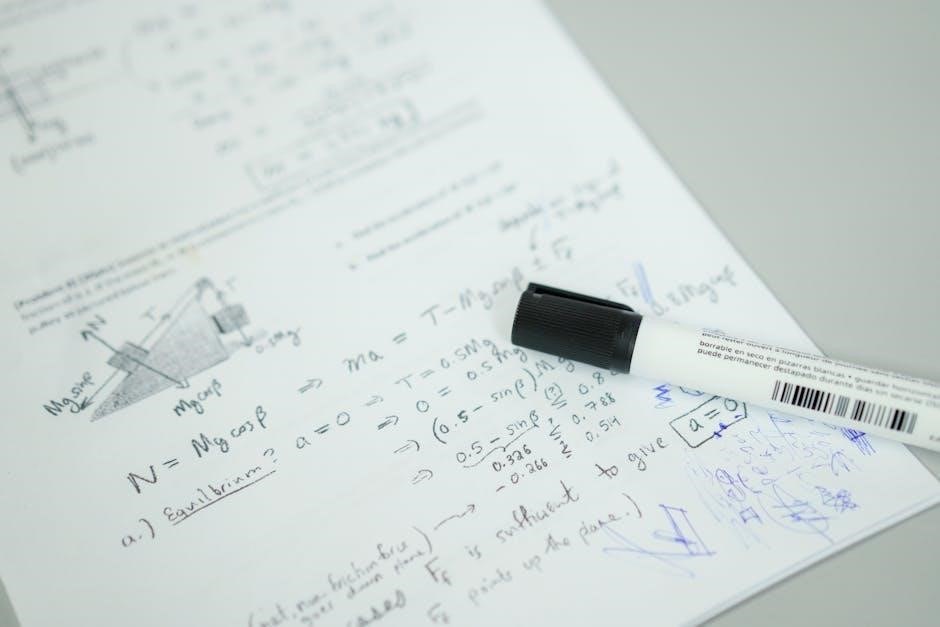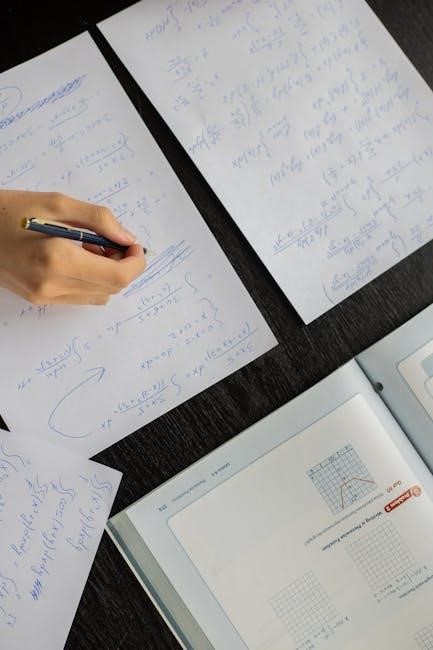Exam P, the Society of Actuaries’ introductory probability exam, is a foundational step in actuarial certification. It assesses understanding of probability, calculus, and risk assessment, essential for actuarial roles. Passing Exam P demonstrates mastery of key mathematical concepts crucial for advanced exams and professional success.
1.1 Overview of Exam P
Exam P, administered by the Society of Actuaries (SOA), is a multiple-choice exam consisting of 25 questions. It focuses on probability concepts, calculus applications, and risk assessment techniques. Candidates have 3 hours to complete the exam, which is a foundational step in the actuarial certification process.
The exam emphasizes understanding probability theory, distribution functions, and stochastic processes. It also covers practical applications in actuarial science, such as financial risk assessment. To succeed, candidates must demonstrate a strong grasp of mathematical principles and their real-world applications.
Popular study resources include the ASM, ACTEX, and Coaching Actuaries guides, which provide comprehensive materials and practice questions. These resources help candidates master the syllabus and build problem-solving skills. Effective preparation involves understanding key concepts, practicing with past papers, and utilizing online forums for support.
1.2 Importance of Exam P in Actuarial Certification
Exam P holds significant importance as the first major milestone in the actuarial certification process, particularly for those pursuing a career in life or property and casualty insurance. It serves as a foundational exam that validates a candidate’s understanding of probability and risk assessment, which are critical skills for actuaries. Passing Exam P demonstrates a strong mathematical aptitude and problem-solving ability, essential for advanced exams in the actuarial pathway.
Moreover, Exam P is a prerequisite for progressing to specialized tracks within the SOA or CAS (Casualty Actuarial Society) certifications. It sets the stage for more complex topics in subsequent exams, such as financial mathematics, actuarial models, and insurance company operations. Employers often view Exam P as a key indicator of a candidate’s potential to excel in the actuarial profession.
Completing Exam P early in one’s career also provides a competitive edge in the job market. It signals dedication and readiness to tackle the challenges of actuarial work, making it a vital step for aspiring actuaries aiming to build a successful and impactful career in the field.

Study Materials for Exam P
Various study guides, such as ASM, ACTEX, and TIA, provide comprehensive resources for Exam P preparation. These materials include detailed notes, practice questions, and study tips to help candidates master probability and risk assessment concepts effectively.
2.1 Overview of Available Study Guides
Several study guides are available to help candidates prepare for Exam P, each offering unique resources and approaches. These guides are designed to cover the exam’s syllabus comprehensively, focusing on probability, statistics, and risk assessment. Popular options include ASM, ACTEX, and TIA study guides, which provide detailed explanations, practice questions, and sample exam papers. Additionally, Coaching Actuaries offers a modern, interactive approach with online tools and video lessons. These materials are tailored to different learning styles, ensuring candidates can choose the resources that best suit their needs. Many guides also include tips for effective studying and test-taking strategies. By leveraging these study guides, candidates can gain a deeper understanding of the exam’s content and improve their chances of success. Regular updates ensure the materials align with the latest exam syllabus, making them reliable choices for thorough preparation.
2.2 ASM Study Guide
The ASM Study Guide is a widely recognized resource for Exam P preparation, known for its comprehensive coverage of probability concepts and risk assessment techniques. It provides detailed explanations of key topics, such as probability distributions, expected values, and stochastic processes, ensuring a strong foundational understanding. The guide includes numerous practice questions and worked examples, allowing candidates to test their knowledge and apply theoretical concepts to practical problems. One of the standout features of the ASM Study Guide is its structured format, which breaks down complex topics into manageable sections. Additionally, it offers tips for effective studying and strategies for tackling exam questions. Many candidates appreciate its clarity and depth, making it an essential tool for mastering the syllabus. By focusing on both theoretical and practical aspects, the ASM Study Guide equips aspiring actuaries with the skills and confidence needed to excel in Exam P.
2.3 ACTEX Study Guide
The ACTEX Study Guide is another highly regarded resource for Exam P preparation, offering a concise yet comprehensive approach to probability concepts. Known for its clarity and organization, it provides detailed explanations of key topics such as probability distributions, conditional probability, and Bayesian concepts. The guide is particularly praised for its ability to simplify complex ideas, making it accessible to students at all levels of understanding. It includes a wide range of practice questions that mirror the actual exam format, allowing candidates to assess their knowledge and identify areas for improvement. Additionally, the ACTEX Study Guide is regularly updated to reflect changes in the exam syllabus, ensuring relevance and accuracy. Many candidates appreciate its focus on practical applications, which helps bridge the gap between theory and real-world problem-solving. With its structured approach and emphasis on understanding, the ACTEX Study Guide is a valuable tool for anyone aiming to master the principles of probability and succeed in Exam P.
2.4 TIA Study Guide
The TIA Study Guide, provided by The Infinite Actuary (TIA), is a widely used and respected resource for Exam P preparation. It is known for its comprehensive coverage of probability concepts and its ability to break down complex topics into easily digestible sections. The guide is particularly noted for its detailed explanations of probability distributions, Bayesian methods, and conditional probability, which are critical for success on the exam. TIA also offers an extensive set of practice questions that closely mirror the actual exam format, allowing candidates to test their knowledge under timed conditions. Additionally, the guide includes interactive learning tools and video lessons, making it a versatile option for different learning styles. Many candidates appreciate the clear structure and focus on practical application, which helps in building a strong foundation for the exam. With its thorough approach and emphasis on understanding, the TIA Study Guide is a reliable choice for those aiming to excel in Exam P.
2.5 Coaching Actuaries Guide
The Coaching Actuaries Guide is a highly regarded study resource for Exam P, designed to help candidates master probability concepts effectively. It stands out for its structured approach, combining video lessons, practice questions, and interactive tools to cater to diverse learning preferences. The guide emphasizes understanding core probability principles, which are fundamental to success on the exam. One of its key features is the use of adaptive learning technology, which tailors the study material to individual needs, identifying weak areas and providing targeted practice. Additionally, Coaching Actuaries offers a comprehensive bank of practice questions that simulate the exam environment, helping candidates build both knowledge and time management skills. The guide also includes a detailed study schedule, ensuring candidates stay organized and motivated throughout their preparation. With its modern approach and focus on practical application, the Coaching Actuaries Guide has become a favorite among aspiring actuaries aiming to conquer Exam P.

Preparation Strategies
Effective preparation for Exam P involves creating a structured study plan, utilizing active learning techniques, and practicing consistently. Focus on understanding key concepts, managing time wisely, and reviewing material regularly to build confidence and mastery of probability principles.
3.1 Effective Study Tips
To excel in Exam P, employ a combination of focused learning and practical application. Start by breaking down the syllabus into manageable sections, prioritizing probability theory and calculus applications. Dedicate time to solving practice problems daily, as this reinforces conceptual understanding. Use active learning techniques, such as teaching the material to someone else or creating self-tests, to deepen retention. Flashcards can be useful for memorizing key formulas and definitions. Additionally, allocate time for regular review sessions to ensure long-term retention of complex concepts. Avoid cramming by spreading study sessions evenly over time. Finally, simulate exam conditions during practice to build stamina and reduce anxiety. By integrating these strategies, candidates can approach Exam P with confidence and a solid foundation in probability principles.
3.2 Time Management Techniques
Effective time management is crucial for success in Exam P. Start by creating a detailed study schedule that allocates specific time blocks to each topic, ensuring a balanced approach. Prioritize challenging areas, such as probability distributions, and dedicate more time to mastering them. Use a calendar or planner to track progress and set realistic milestones. Incorporate regular breaks into your study sessions to maintain focus and prevent burnout. The Pomodoro Technique—25 minutes of study followed by a 5-minute break—can enhance productivity. Allocate separate time slots for problem-solving and theoretical review to avoid mixing tasks. Additionally, simulate exam conditions by setting timers for practice questions to build time-awareness. Avoid overloading your schedule; instead, allow flexibility for adjustments. By consistently adhering to your plan and reviewing progress weekly, you can optimize your preparation and ensure thorough coverage of all topics before exam day.
3.3 Understanding the Exam Format
Understanding the format of Exam P is essential for effective preparation. The exam consists of 30 multiple-choice questions, and candidates are allotted 3 hours to complete it. Each question is equally weighted, so managing time to answer all questions is critical. The exam covers a wide range of topics, including probability theory, distributions, and calculus applications, with a focus on problem-solving and theoretical understanding. Familiarize yourself with the question structure, as some problems may involve multi-step calculations or conceptual explanations. Practice reviewing past papers to get accustomed to the exam’s pace and complexity. Knowing the format helps in allocating time wisely, ensuring no section is left unattempted. Additionally, understanding the emphasis on applied knowledge versus theoretical concepts can guide your study focus. By grasping the exam structure, you can approach the test with confidence and maximize your performance. Regularly reviewing the syllabus and question types will further enhance your readiness for the exam.

Practice Tests and Questions
Practice tests and questions are vital for assessing readiness and identifying weak areas. Regularly attempting sample questions helps refine problem-solving skills and builds familiarity with the exam format. Consistent practice enhances confidence and accuracy, ensuring a strong performance on exam day.
4.1 Role of Practice Tests in Preparation
Practice tests play a pivotal role in preparing for Exam P by simulating real exam conditions and helping candidates assess their readiness. They allow individuals to identify strengths and weaknesses, enabling focused study on challenging topics. Regularly taking practice tests enhances problem-solving skills, improves time management, and builds confidence. Additionally, these tests familiarize candidates with the exam format, question types, and difficulty levels, reducing anxiety on exam day. Reviewing mistakes and understanding correct solutions are crucial steps that reinforce learning and refine problem-solving strategies. Consistent practice also helps develop a rhythm and pacing that align with the exam’s timing, ensuring candidates can complete all questions efficiently. By integrating practice tests into their study routine, aspiring actuaries can systematically improve their performance and approach the exam with greater assurance and preparedness.
4.2 Analysis of Sample Questions
Analyzing sample questions is an essential step in preparing for Exam P, as it provides direct insight into the exam’s content, structure, and difficulty. By reviewing sample questions, candidates can gain a better understanding of how concepts are tested and identify areas where they may need additional study. Sample questions often reflect the most commonly tested topics, such as probability distributions, expected values, and conditional probability. Breaking down these questions step-by-step helps candidates improve their problem-solving techniques and time management. Additionally, analyzing sample questions allows individuals to recognize patterns and recurring themes, which can guide their study efforts. Understanding the reasoning behind correct answers and common pitfalls is crucial for avoiding mistakes. Regularly working through sample questions enhances familiarity with the exam format and builds confidence in tackling challenging problems. This process ensures that candidates are well-prepared for the types of questions they will encounter on exam day.

Key Concepts Covered in Exam P
Exam P focuses on probability, statistics, and risk assessment. Key concepts include probability distributions, expected values, conditional probability, and Bayesian methods. Understanding these is crucial for actuarial applications.
5.1 Basics of Probability Theory
The foundation of Exam P lies in understanding probability theory, which includes fundamental concepts such as sample spaces, events, and probability measures. Key topics cover the basics of probability rules, conditional probability, and independence. Students must grasp how to calculate probabilities using combinations and permutations, as well as apply probability axioms.
Understanding probability distributions is also crucial, with a focus on discrete and continuous distributions. Common distributions like the Bernoulli, binomial, and uniform distributions are emphasized. Additionally, the concept of expected value and variance is introduced, forming the backbone for more advanced topics in the exam.
Probability theory is essential for actuaries, as it provides the tools to model uncertainty and make informed decisions. Mastery of these concepts ensures a strong foundation for tackling more complex problems in risk assessment and statistical analysis.

5.2 Applications of Calculus

Calculus plays a vital role in Exam P, as it provides essential tools for modeling and analyzing continuous phenomena. Key applications include understanding limits, derivatives, and integrals, which are fundamental for solving problems in probability and risk assessment. Derivatives are used to determine rates of change, while integrals are applied to calculate accumulations over intervals.
Students are expected to apply calculus to solve problems involving sequences, series, and continuous functions. Concepts like optimization using derivatives and understanding the behavior of functions through calculus are critical. Additionally, calculus is used to derive probability distributions and expected values, bridging the gap between theoretical probability and practical applications.
Mastery of calculus ensures that actuaries can handle complex mathematical models, making it a cornerstone of the exam. Regular practice with calculus-based problems is essential to build both speed and accuracy.
5.3 Techniques in Risk Assessment
Risk assessment is a cornerstone of actuarial science, and Exam P extensively tests techniques used to evaluate and mitigate risks. Key techniques include probability distributions, Monte Carlo simulations, and sensitivity analysis. These methods help actuaries quantify uncertainty and predict potential outcomes in complex systems.
A strong understanding of probability theory is essential, as it forms the basis for advanced risk modeling. Tools like decision trees and scenario analysis are also emphasized, enabling actuaries to identify and prioritize risks. Additionally, the exam covers the application of statistical methods to historical data, allowing for more accurate risk predictions.

Mastery of these techniques enables actuaries to develop robust risk management strategies, making them indispensable in fields like insurance, finance, and investments. Regular practice with real-world scenarios ensures proficiency in applying these methods effectively.

Additional Resources
Explore recommended textbooks, online forums, and study tools to enhance your Exam P preparation. These resources provide supplementary learning materials, peer support, and practical aids to reinforce your understanding of key concepts and techniques.
6.1 Recommended Textbooks
by Sheldon Ross is a popular choice, offering comprehensive coverage of probability theory. A First Course in Probability by Geoffrey Grimmett and David Stirzaker provides clear explanations and practical examples. Additionally, Probability and Computing by Mitzenmacher and Upfal is excellent for algorithmic approaches, while Probability: Theory and Examples by Durrett offers rigorous mathematical foundations. These textbooks complement study guides by providing detailed derivations and additional practice problems. They are particularly useful for candidates seeking a deeper understanding of probability concepts and their applications. By incorporating these resources, aspirants can strengthen their grasp of Exam P topics and improve their problem-solving skills. These books are widely regarded as indispensable tools for actuarial students aiming to excel in probability-based exams.
6.2 Online Forums and Communities
Online forums and communities play a vital role in Exam P preparation by providing a platform for discussion, advice, and shared resources. Platforms like Reddit’s r/actuary and r/examp are popular among candidates, offering a space to ask questions, share study tips, and discuss challenges. The Actuarial Outpost forum is another highly recommended resource, where aspiring actuaries can engage with experienced professionals and access threads dedicated to Exam P strategies. These communities often feature threads on common pitfalls, study material recommendations, and exam-taking techniques. Additionally, Facebook groups and LinkedIn groups focused on actuarial exams provide opportunities to connect with peers and gain insights from those who have successfully passed Exam P. Active participation in these forums can help candidates stay motivated and gain a deeper understanding of complex topics. They also serve as a support system, reducing feelings of isolation during the rigorous study process. Engaging with these communities can be a valuable supplement to traditional study materials.
6.3 Flashcards and Other Study Tools
Flashcards and other study tools are essential for reinforcing key concepts and formulas in Exam P preparation. Anki, a popular spaced-repetition flashcard app, is widely used by candidates to memorize probability distributions, calculus formulas, and risk assessment techniques. Flashcards can be created manually or downloaded from resources like Quizlet or Brute Force Learning, which offer pre-made decks tailored for actuarial exams. These tools allow for active recall practice, a proven method for long-term retention of information. Additionally, apps like Quizlet provide interactive games and tests to make studying engaging. For visual learners, mind maps and concept charts can help organize complex topics like probability theory and calculus applications. Many candidates also use spreadsheets to track their progress and identify weak areas. These tools complement traditional study materials and provide a flexible way to review concepts on the go. By incorporating flashcards and other study aids, candidates can enhance their understanding and retention of key Exam P material.

Exam Day Tips
Arrive early, stay calm, and ensure all materials are ready. Deep breathing helps manage nerves. Skim questions first, then tackle easier ones. Budget time wisely, and review answers if possible. Stay focused and confident throughout the exam.
7.1 Final Preparations
Final preparations for Exam P require a strategic approach to ensure readiness. Begin by reviewing key formulas, probability distributions, and calculus concepts. Timing is crucial, so practice solving problems within the allotted time. Ensure your calculator is fully charged and familiarize yourself with its functions. Organize your study materials, including notes and flashcards, for quick reference. On the eve of the exam, avoid intense studying and focus on relaxation techniques, such as light exercise or meditation, to maintain a clear mind. Get a full night’s sleep to ensure mental sharpness. On exam day, arrive early at the test center with all necessary documents and materials. Eat a nutritious meal to sustain energy levels throughout the exam. Avoid discussing new topics or last-minute cramming, as this can increase anxiety. Trust your preparation and stay confident—this mindset will help you approach the exam with clarity and focus.
7.2 Effective Test-Taking Strategies
Effective test-taking strategies are essential for maximizing performance on Exam P. Time management is critical, as candidates must answer 30 questions in 170 minutes. Allocate approximately 5 minutes per question, but adjust based on difficulty. Start with questions you find easier to build confidence and momentum. Skim through the entire exam first to identify straightforward problems and tackle them early. For complex questions, use the process of elimination to narrow down answer choices, increasing the likelihood of selecting the correct one. Always recheck calculations to avoid arithmetic errors, which are common under exam pressure. Maintain a steady pace and avoid spending too much time on a single question. If stuck, mark the question and return to it later to prevent wasting valuable time. Finally, stay calm and focused throughout the exam. A clear mind and systematic approach will help you navigate the challenges of Exam P effectively.